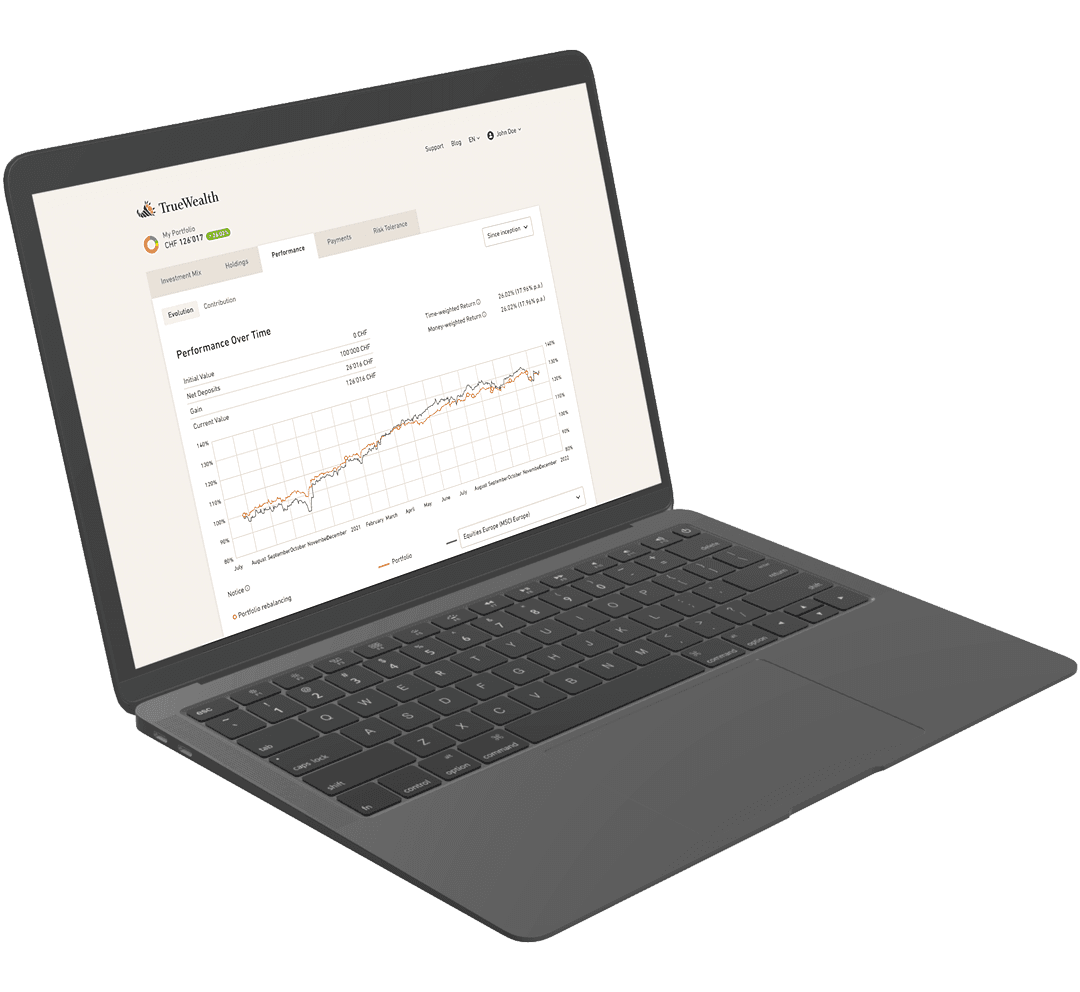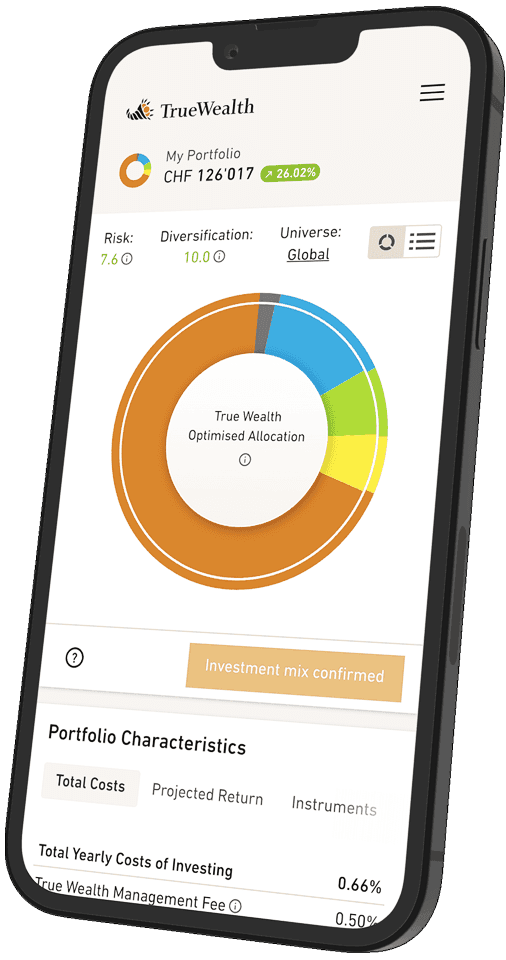
Rebalancing: An Extra Half a Percent
Less fluctuation and higher returns – that's what diversification brings to a portfolio. But only if it is restored on a regular basis.
A well-diversified portfolio fluctuates less in value. To ensure that the portfolio is not only diversified at the start, but can also exploit all its advantages over time, it needs to be regularly adjusted – known as rebalancing.
Rebalancing is so important that we at True Wealth carry out around 40 trades a year in our clients' portfolios – fully automatically and at no extra cost.
Just diversifying at the beginning is not enough
When you create a portfolio, you first define strategic guidelines. You determine the asset allocation based on your personal risk appetite and investment horizon. You determine what proportion of your assets you want to hold in which asset classes. For example, what percentage should be in equities, bonds, commodities or real estate.
Over time, however, your portfolio will not stick to the initial allocation you have specified. This is because prices develop differently. Let's take a brief look at this using an example.
Let's assume you invest CHF 100'000 and decide on the following asset allocation: 45 percent equities, 45 percent bonds, 5 percent real estate and 5 percent commodities. Your portfolio would look like this today:
In six months, the shares will have shifted. For our example, let's assume that the stock market has performed exceptionally well with a 20 percent price gain and that all other investments have gained a moderate 2 percent each. Then this would be your new asset allocation:
Real estate and commodities now account for just under 5% of the overall portfolio. The balance between equities and bonds has shifted significantly.
Rebalancing against shifts
To restore the planned proportions, the following reallocations are necessary: you sell shares for CHF 4'455. You use the proceeds to buy bonds for CHF 3'645. You also buy real estate and commodities for 405 francs each. The portfolio is then balanced as follows:
Even in this simplified example, rebalancing requires four trades. However, a well-diversified portfolio contains not just four investment instruments – but many more. (Depending on the risk profile, our clients' portfolios consist on average of 20 to 30 individual ETFs and index funds. Rebalancing requires around 40 such rebalancing trades per year).
Why do we do this?
Rebalancing maintains the effect of diversification in the long term. And it frees the human mind from the all-too-human traps. This results in these three advantages:
- Better returns
- Fewer fluctuations
- Clear rules
Advantage 1: Better returns
If you want returns, you have to take on risk. But if you diversify, you can achieve the maximum return with a minimum of risk. Rebalancing ensures that diversification is maintained in the long term and can work as initially planned. (You can read more about why diversification is so important and exactly how it works in the article: «Put all your Eggs in one Basket: Diversification»).
David Swensen, one of the best portfolio managers in the world and former Chief Investment Officer at Yale University, put the benefit at 0.4 percent. That's how much extra return rebalancing can bring - every year. (More on this in his book: «Unconventional Success»)
Advantage 2: Fewer fluctuations
When rebalancing, the return from the asset classes that have performed better is used to buy what has performed less well. This balances out fluctuations.
Fluctuations in value cannot be completely avoided. If you want more return than is possible with a risk-free money market account, you have to take on risk. But it is better to achieve the excess return with fewer fluctuations. The Sharpe ratio is used to measure how well this works in a portfolio.
If you compare the traditional 60/40 portfolio with a world equity portfolio, the Curvo backtesting simulator shows a Sharpe ratio of 0.74 for the diversified portfolio and 0.61 for the equity portfolio. The diversified portfolio therefore outperforms the pure equity portfolio by 20 percent on a risk-weighted basis. However, a long investment period is also decisive (2004 to 2023 was chosen here) – in short phases with less volatile equity markets, a pure equity portfolio can also temporarily have a high Sharpe ratio.
However, this result can only be achieved if diversification is consistently maintained.
Advantage 3: Clear rules
Portfolio rebalancing follows clear rules. The strategically defined proportions of the asset classes are restored. This objective is clear and is achieved with every rebalancing.
There are various methods for determining when and how a rebalancing is carried out. If you carry out the rebalancing yourself, you make your choice beforehand - and then act according to your rules.
Professional investors usually carry out rebalancing according to the following rules:
At fixed points in time. Here you define in advance when the portfolio is to be rebalanced. For example, each client portfolio is rebalanced to the strategic distribution every six months.
At fixed threshold values. Here you define the percentage by which an asset class may deviate from its target value. If a maximum deviation of five percent is permitted and the proportion of shares has risen from 45 to 51 percent, this increase forces an immediate rebalancing – even if it has not been long since the last rebalancing.
Whether at fixed points in time or after fixed thresholds, rebalancing is always anti-cyclical. If shares have fallen, the increased proportion of bonds finances the purchase of additional shares that are now cheaper. Those who rely on rebalancing need have no fear of a crash. On the contrary: they use the correction on the stock market as an opportunity.
Rebalancing included
With these advantages, it is clear that rebalancing is so important that no portfolio should be managed without rebalancing. However, if you manage your portfolio yourself and pay transaction fees for each trade, you may avoid the necessary rebalancing. After all, 40 trades can quickly add up to hundreds of francs, even with the cheapest Swiss online brokers.
We think so: Rebalancing is a must. That's why we not only carry it out for you fully automatically without you having to do anything. We also do it at no extra cost to you – all transactions are already included in the wealth management fee of 0.25-0.50 percent (we deduct brokerage fees charged by the account-holding bank from our management fee).
Even better: in our Pillar 3a, countless transactions do not even have to be executed on the open market. Thanks to pooling and netting in the pension foundation's account, numerous transactions can be settled internally, resulting in cost savings that we pass on in full.
Whether for asset management or the 3rd pillar: we have developed our own rebalancing algorithm. We use it to automatically keep your portfolio on track and transaction costs low. We do this according to threshold values: the deviations from your investment strategy are usually less than two percent.
You can see how well this works in your portfolio – or you can simply try it out with a virtual test account.
Links
- Felix Niederer: «Put all your Eggs in one Basket: Diversification»
- David F. Swensen: «Unconventional Success – A Fundamental Approach to Personal Investment» New York, Simon and Schuster, 2005
- Elizabeth MacBride: «The Benefits of Diversification»
- Oliver Herren: «Wealth management: Even cheaper than trading yourself»
About the author

Oliver is one of the founders of Switzerland's largest online shops: the online retailer Galaxus and the electronics specialist Digitec. Together with Felix, he launched True Wealth AG in 2013.

Ready to invest?
Open accountNot sure how to start? Open a test account and upgrade to a full account later.
Open test account